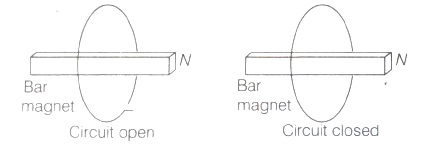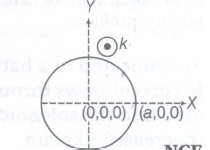CBSE 12th Standard Physics Subject Electromagnetic Induction Ncert Exemplar 2 Mark Questions With Solutions 2021
By QB365
QB365 Provides the updated NCERT Exemplar Questions for Class 12, and also provide the detail solution for each and every case study questions. NCERT Exemplar questions are latest updated question pattern from NCERT, QB365 will helps to get more marks in Exams
QB365 - Question Bank Software
CBSE 12th Standard Physics Subject Electromagnetic Induction Ncert Exemplar 2 Mark Questions With Solutions 2021
12th Standard CBSE
-
Reg.No. :
Physics
-
Consider a closed loop C in a magnetic field as shown in the figure. The flux passing through the loop is defined by choosing a surface whose edge coincides with the loop and using the formula
\(\phi \) = B1 dA1, B2 dA2....Now, if we choose two different surfaces S1 and S2 having C as their edge, would we get the same answer for flux. Justify your answer.
 (a)
(a) -
(i) A metal ring is held horizontally and a bar magnet is dropped through the ring with its length along the axis of the ring. What will be the acceleration of a falling magnet?
(ii) Consider a metal ring kept on top of a fixed solenoid (say on cardboard) (see figure). The center of the ring coincides with the axis of the solenoid. If the current is suddenly switched ON, the metal ring jumps up. Explain.
 (a)
(a) -
Consider a magnet surrounded by a wire with an ON/OFF switch as shown in the figure. If the switch is thrown from the OFF position (open circuit) to the ON position (closed circuit), will a current flow in the circuit? Explain
 (a)
(a) -
A solenoid is connected to a battery, so that a steady current flows through it. If an iron core is inserted into the solenoid, will the current increase or decrease? Explain
(a) -
Amagnetic field in a certain region is given by \(\mid \mathbf{B}=B_{0} \cos (\omega t) \hat{\mathbf{k}}\) and a coil of radius a with resistance R, is placed in the xy-plane with its centre at the origin in the magnetic field as shown in the figure. Find the magnitude and the direction of the current at (a, 0, 0) at
\(t=\frac{\pi}{2 \omega}, t=\frac{\pi}{\omega} \text { and } t=\frac{3 \pi}{2 \omega}\)
 (a)
(a)































